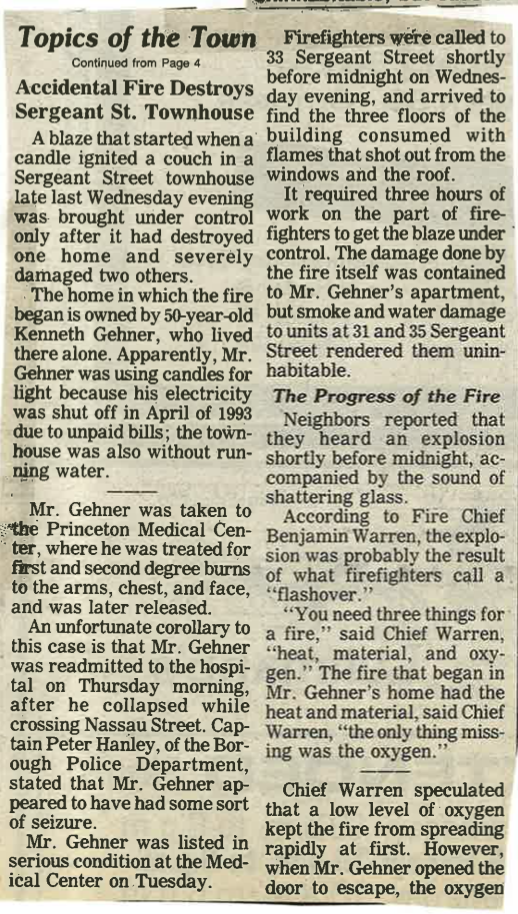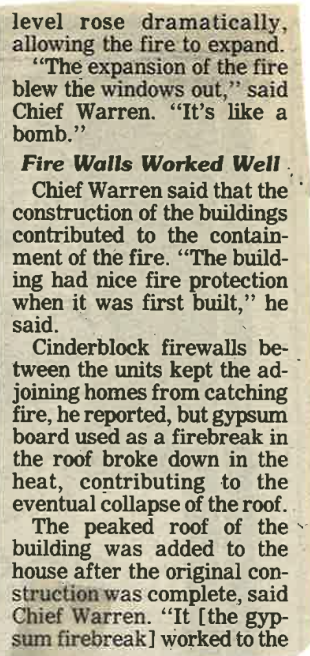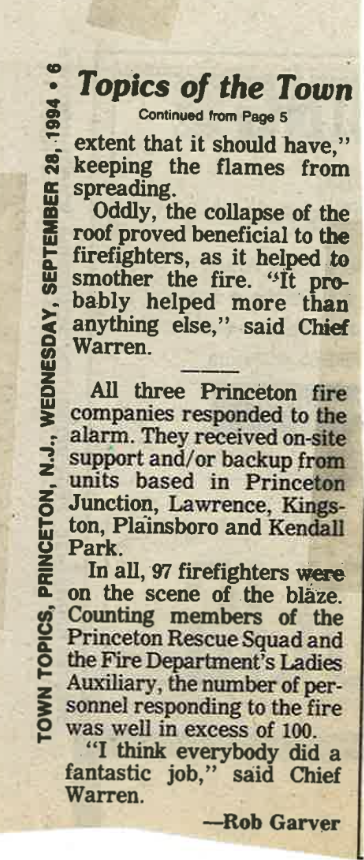
September 28, 1994
Accidental Fire Destroys Sergeant St. Townhouse
A blaze that started when a candle ignited a couch in a Sergeant Street townhouse late last Wednesday evening was brought under control only after it had destroyed one home and severely damaged two others.
The home in which the fire began is owned by 50-year-old Kenneth Gehner, who lived there alone. Apparently, Mr. Gehner was using candles for light because his electricity was shut off in April of 1993 due to unpaid bills; the townhouse was also without running water.
Mr. Gehner was taken to the Princeton Medical Center, where he was treated for first and second degree burns to the arms, chest, and face, and was later released.
An unfortunate corollary to this case is that Mr. Gehner was readmitted to the hospital on Thursday morning, after he collapsed while crossing Nassau Street. Captain Peter Hanley, of the Bor-ough Police Department, stated that Mr. Gehner appeared to have had some sort of seizure.
Mr. Gehner was listed in serious condition at the Medical Center on Tuesday.
Firefighters were called to 33 Sergeant Street shortly before midnight on Wednesday evening, and arrived to find the three floors of the building consumed with flames that shot out from the windows and the roof.
It required three hours of work on the part of firefighters to get the blaze under control. The damage done by the fire itself was contained to Mr. Gehner’s apartment, but smoke and water damage to units at 31 and 35 Sergeant Street rendered them uninhabitable.
The Progress of the Fire
Neighbors reported that they heard an explosion shortly before midnight, accompanied by the sound of shattering glass.
According to Fire Chief Benjamin Warren, the explosion was probably the result of what firefighters call a “flashover.”
“You need three things for a fire,” said Chief Warren. , “heat, material, and oxy- I gen.” The fire that began in Mr. Gehner’s home had the heat and material, said Chief Warren, “the only thing missing was the oxygen.”
Chief Warren speculated that a low level of oxygen kept the fire from spreading rapidly at first. However, when Mr. Gehner opened the door to escape, the oxygen…

…level rose dramatically allowing the fire to expand.
“The expansion of the fire blew the windows out,” said Chief Warren. “It’s like a bomb.”
Fire Walls Worked Well
Chief Warren said that the construction of the buildings contributed to the containment of the fire. “The building had nice fire protection when it was first built,” he said.
Cinderblock firewalls between the units kept the ad-joining homes from catching fire, he reported, but gypsum board used as a firebreak in the roof broke down in the heat, contributing to the eventual collapse of the roof.
The peaked roof of the building was added to the house after the original construction was complete, said Chief Warren. “It [the gypsum firebreak] worked to the…

.. extent that it should have,” keeping the flames from spreading.
Oddly, the collapse of the roof proved beneficial to the firefighters, as it helped to smother the fire. “It probably helped more than anything else,” said Chief Warren.
All three Princeton fire companies responded to the alarm. They received on-site support and/or backup from units based in Princeton Junction, Lawrence, Kings-ton, Plainsboro and Kendall Park.
In all, 97 firefighters were on the scene of the blaze. Counting members of the Princeton Rescue Squad and the Fire Department’s Ladies Auxiliary, the number of personnel responding to the fire was well in excess of 100. “I think everybody did a fantastic job,” said Chief Warren.
– Rob Garver